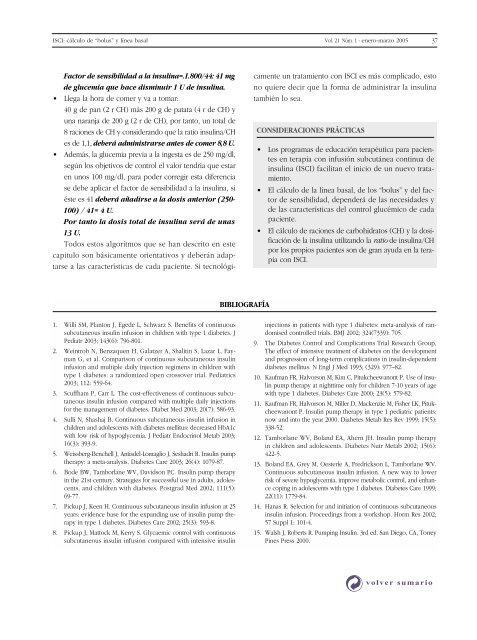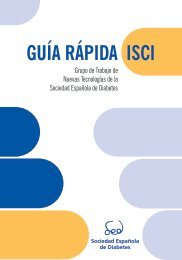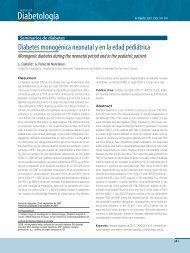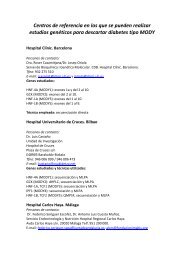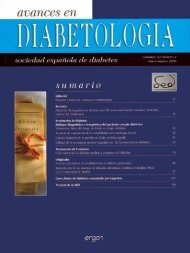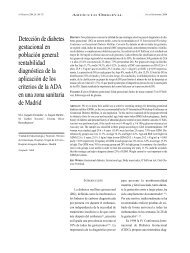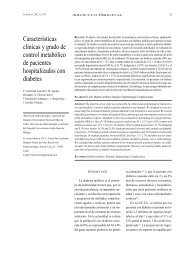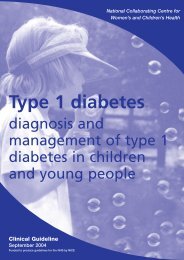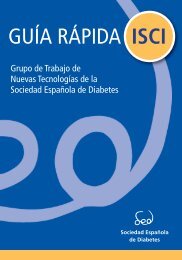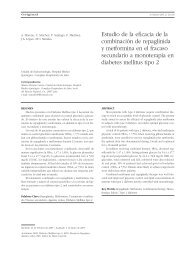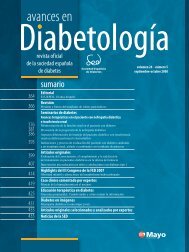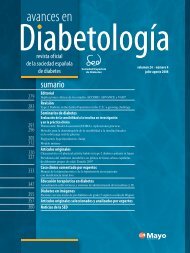Avances en DiabetologÃa - Sociedad Española de Diabetes
Avances en DiabetologÃa - Sociedad Española de Diabetes
Avances en DiabetologÃa - Sociedad Española de Diabetes
- No tags were found...
You also want an ePaper? Increase the reach of your titles
YUMPU automatically turns print PDFs into web optimized ePapers that Google loves.
ISCI: cálculo <strong>de</strong> “bolus” y línea basal Vol. 21 Núm. 1 - <strong>en</strong>ero-marzo 2005 37Factor <strong>de</strong> s<strong>en</strong>sibilidad a la insulina=.1.800/44: 41 mg<strong>de</strong> glucemia que hace disminuir 1 U <strong>de</strong> insulina.• Llega la hora <strong>de</strong> comer y va a tomar:40 g <strong>de</strong> pan (2 r CH) más 200 g <strong>de</strong> patata (4 r <strong>de</strong> CH) yuna naranja <strong>de</strong> 200 g (2 r <strong>de</strong> CH), por tanto, un total <strong>de</strong>8 raciones <strong>de</strong> CH y consi<strong>de</strong>rando que la ratio insulina/CHes <strong>de</strong> 1,1, <strong>de</strong>berá administrarse antes <strong>de</strong> comer 8,8 U.• A<strong>de</strong>más, la glucemia previa a la ingesta es <strong>de</strong> 250 mg/dl,según los objetivos <strong>de</strong> control el valor t<strong>en</strong>dría que estar<strong>en</strong> unos 100 mg/dl, para po<strong>de</strong>r corregir esta difer<strong>en</strong>ciase <strong>de</strong>be aplicar el factor <strong>de</strong> s<strong>en</strong>sibilidad a la insulina, siéste es 41 <strong>de</strong>berá añadirse a la dosis anterior (250-100) / 41= 4 U.Por tanto la dosis total <strong>de</strong> insulina será <strong>de</strong> unas13 U.Todos estos algoritmos que se han <strong>de</strong>scrito <strong>en</strong> estecapitulo son básicam<strong>en</strong>te ori<strong>en</strong>tativos y <strong>de</strong>berán adaptarsea las características <strong>de</strong> cada paci<strong>en</strong>te. Si tecnológicam<strong>en</strong>teun tratami<strong>en</strong>to con ISCI es más complicado, estono quiere <strong>de</strong>cir que la forma <strong>de</strong> administrar la insulinatambién lo sea.CONSIDERACIONES PRÁCTICAS• Los programas <strong>de</strong> educación terapéutica para paci<strong>en</strong>tes<strong>en</strong> terapia con infusión subcutánea continua <strong>de</strong>insulina (ISCI) facilitan el inicio <strong>de</strong> un nuevo tratami<strong>en</strong>to.• El cálculo <strong>de</strong> la línea basal, <strong>de</strong> los “bolus” y <strong>de</strong>l factor<strong>de</strong> s<strong>en</strong>sibilidad, <strong>de</strong>p<strong>en</strong><strong>de</strong>rá <strong>de</strong> las necesida<strong>de</strong>s y<strong>de</strong> las características <strong>de</strong>l control glucémico <strong>de</strong> cadapaci<strong>en</strong>te.• El cálculo <strong>de</strong> raciones <strong>de</strong> carbohidratos (CH) y la dosificación<strong>de</strong> la insulina utilizando la ratio <strong>de</strong> insulina/CHpor los propios paci<strong>en</strong>tes son <strong>de</strong> gran ayuda <strong>en</strong> la terapiacon ISCI.BIBLIOGRAFÍA1. Willi SM, Planton J, Ege<strong>de</strong> L, Schwarz S. B<strong>en</strong>efits of continuoussubcutaneous insulin infusion in childr<strong>en</strong> with type 1 diabetes. JPediatr 2003; 143(6): 796-801.2. Weintrob N, B<strong>en</strong>zaqu<strong>en</strong> H, Galatzer A, Shalitin S, Lazar L, FaymanG, et al. Comparison of continuous subcutaneous insulininfusion and multiple daily injection regim<strong>en</strong>s in childr<strong>en</strong> withtype 1 diabetes: a randomized op<strong>en</strong> crossover trial. Pediatrics2003; 112: 559-64.3. Scuffham P, Carr L. The cost-effectiv<strong>en</strong>ess of continuous subcutaneousinsulin infusion compared with multiple daily injectionsfor the managem<strong>en</strong>t of diabetes. Diabet Med 2003; 20(7): 586-93.4. Sulli N, Shashaj B. Continuous subcutaneous insulin infusion inchildr<strong>en</strong> and adolesc<strong>en</strong>ts with diabetes mellitus: <strong>de</strong>creased HbA1cwith low risk of hypoglycemia. J Pediatr Endocrinol Metab 2003;16(3): 393-9.5. Weissberg-B<strong>en</strong>chell J, Antis<strong>de</strong>l-Lomaglio J, Seshadri R. Insulin pumptherapy: a meta-analysis. <strong>Diabetes</strong> Care 2003; 26(4): 1079-87.6. Bo<strong>de</strong> BW, Tamborlane WV, Davidson PC. Insulin pump therapyin the 21st c<strong>en</strong>tury. Strategies for successful use in adults, adolesc<strong>en</strong>ts,and childr<strong>en</strong> with diabetes. Postgrad Med 2002; 111(5):69-77.7. Pickup J, Ke<strong>en</strong> H. Continuous subcutaneous insulin infusion at 25years: evid<strong>en</strong>ce base for the expanding use of insulin pump therapyin type 1 diabetes. <strong>Diabetes</strong> Care 2002; 25(3): 593-8.8. Pickup J, Mattock M, Kerry S. Glycaemic control with continuoussubcutaneous insulin infusion compared with int<strong>en</strong>sive insulininjections in pati<strong>en</strong>ts with type 1 diabetes: meta-analysis of randomisedcontrolled trials. BMJ 2002; 324(7339): 705.9. The <strong>Diabetes</strong> Control and Complications Trial Research Group,The effect of int<strong>en</strong>sive treatm<strong>en</strong>t of diabetes on the <strong>de</strong>velopm<strong>en</strong>tand progression of long-term complications in insulin-<strong>de</strong>p<strong>en</strong>d<strong>en</strong>tdiabetes mellitus. N Engl J Med 1993; (329): 977–82.10. Kaufman FR, Halvorson M, Kim C, Pitukcheewanont P. Use of insulinpump therapy at nighttime only for childr<strong>en</strong> 7-10 years of agewith type 1 diabetes. <strong>Diabetes</strong> Care 2000; 23(5): 579-82.11. Kaufman FR, Halvorson M, Miller D, Mack<strong>en</strong>zie M, Fisher LK, PitukcheewanontP. Insulin pump therapy in type 1 pediatric pati<strong>en</strong>ts:now and into the year 2000. <strong>Diabetes</strong> Metab Res Rev 1999; 15(5):338-52.12. Tamborlane WV, Boland EA, Ahern JH. Insulin pump therapyin childr<strong>en</strong> and adolesc<strong>en</strong>ts. <strong>Diabetes</strong> Nutr Metab 2002; 15(6):422-5.13. Boland EA, Grey M, Oesterle A, Fredrickson L, Tamborlane WV.Continuous subcutaneous insulin infusion. A new way to lowerrisk of severe hypoglycemia, improve metabolic control, and <strong>en</strong>hancecoping in adolesc<strong>en</strong>ts with type 1 diabetes. <strong>Diabetes</strong> Care 1999;22(11): 1779-84.14. Hanas R. Selection for and initiation of continuous subcutaneousinsulin infusion. Proceedings from a workshop. Horm Res 2002;57 Suppl 1: 101-4.15. Walsh J, Roberts R. Pumping Insulin. 3rd ed. San Diego, CA, TorreyPines Press 2000.volver sumario


